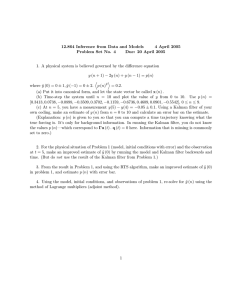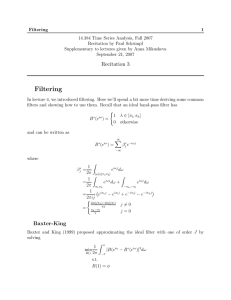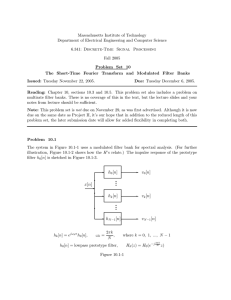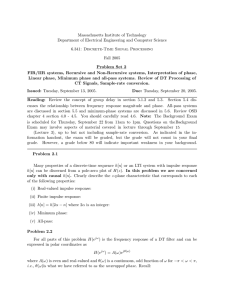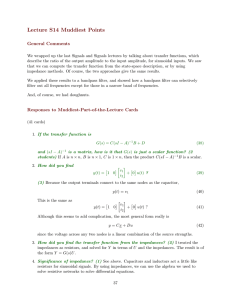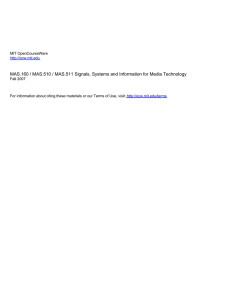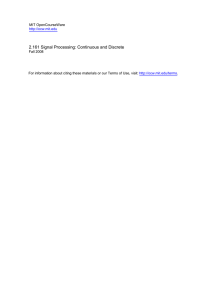2.161 Signal Processing: Continuous and Discrete MIT OpenCourseWare rms of Use, visit: .
advertisement
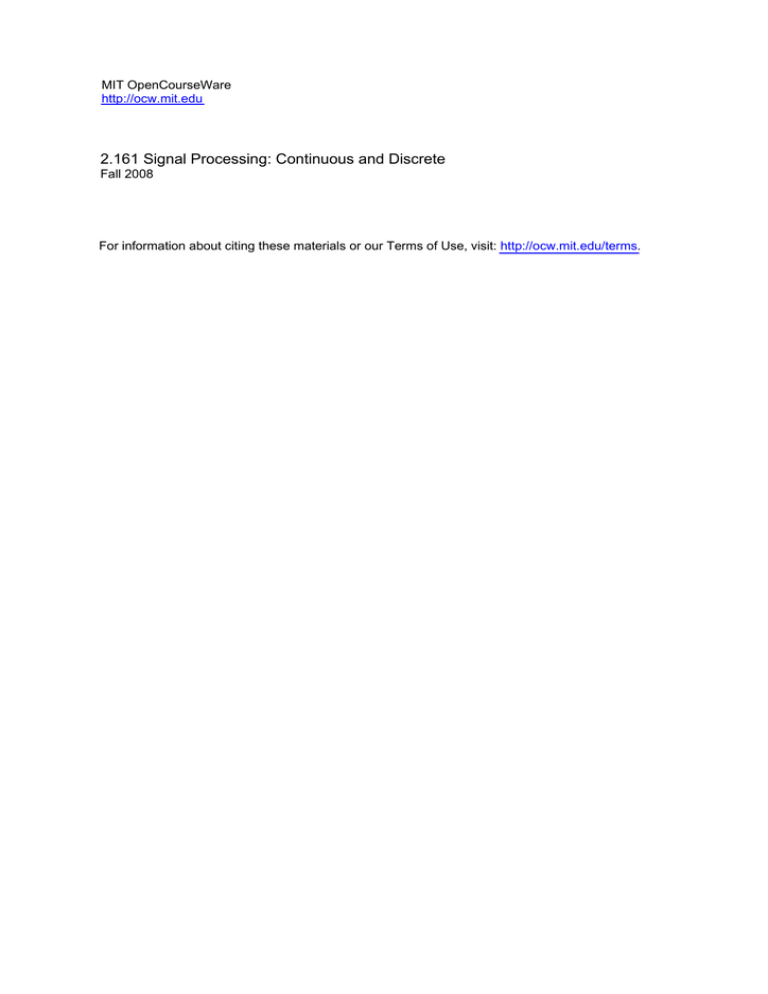
MIT OpenCourseWare http://ocw.mit.edu 2.161 Signal Processing: Continuous and Discrete Fall 2008 For information about citing these materials or our Terms of Use, visit: http://ocw.mit.edu/terms. MASSACHUSETTS INSTITUTE OF TECHNOLOGY DEPARTMENT OF MECHANICAL ENGINEERING 2.161 Signal Processing – Continuous and Discrete Op-Amp Implementation of Analog Filters.1 1 Introduction Practical realizations of analog filters are usually based on factoring the transfer function into cascaded second-order sections, each based on a complex conjugate pole-pair or a pair of real poles, and a first-order section if the order is odd. Any zeros in the system may be distributed among the second- and first-order sections. Each first- and second-order section is then implemented by an active filter and connected in series. For example the third-order Butterworth high-pass filter s3 H(s) = 3 s + 40s2 + 800s + 8000 would be implemented as H(s) = s2 s × 2 s + 20s + 400 s + 20 as shown in Fig. 1. The design of each low-order block can be handled independently. s s 3 + 4 0 s 2 3 s + 8 0 0 s + 8 0 0 0 (a ) 2 s 2 s s + 2 0 + 2 0 s + 4 0 0 (b ) Figure 1: A third-order Butterworth filter (a) as a single third-order section, and (b) as a second-order and first-order section cascaded. State-variable active filters 2 The state-variable filter design method is based on the block diagram representation used in the so-called phase-variable description of linear systems that uses the outputs of a chain of cascaded integrators as state variables. Consider a second-order filter block with a transfer function b2 s2 + b1 s + b0 Y (s) (1) H(s) = = 2 U (s) s + a1 s + a0 1 D. Rowell October 2, 2008 1 and split H(s) into two sub-blocks representing the denominator and numerator by intro­ ducing an intermediate variable x and rewrite X(s) 1 = 2 U (s) s + a1 s + a0 Y (s) = b2 s2 + b1 s + b0 H2 (s) = X(s) so that H(s) = H2 (s)H1 (s). H1 (s) = (2) (3) The differential equations corresponding to Eqs. (2) and (3) are dx d2 x + a1 + a0 x = u 2 dt dt (4) and d2 x dx + b0 x. + b1 2 dt dt Rewrite Eq. (4) explicitly in terms of the highest derivative y = b2 (5) dx d2 x − a0 x + u. = −a1 2 dt dt (6) Consider a pair of cascaded analog integrators with the output defined as x(t), as shown in Fig. 2, so that the derivatives of x(t) appear as inputs to the integrators. Note that Eq. (6) d x 2 d t 2 d x d t 1 s 1 x (t) s Figure 2: Cascaded integrators with output x(t). gives an explicit expression for the input to the first block in terms of the outputs of the two integrators and the system input, and therefore generates the block diagram for H1 (s) (Eq. (5)) shown in Fig. 3. u (t) d + - d t - 2 2 x d x d t 1 s a 1 1 x (t) s a 0 Figure 3: State variable realization of H1 (s) = X(s)/U (s). 2 + b u (t) b 2 + s - d x d t 2 - a 0 1 x (t) s d x d t y (t) + b 1 1 2 + + a 1 0 Figure 4: Full second-order state variable realization. Equation (5) shows that the output y(t) is a weighted sum of x(t) and its derivatives, leading to the complete second-order state variable filter block shown in Fig. 4. This basic structure may be used to realize the four basic filter types by appropriate choice of the numerator. Figure 5 shows how the output may be selected to achieve the following transfer functions: Y1 (s) U (s) Y2 (s) Hbp (s) = U (s) Y3 (s) Hhp (s) = U (s) Y4 (s) Hbs (s) = U (s) Hlp (s) = a0 + a1 s + a0 a1 s = 2 s + a1 s + a0 s2 = 2 s + a1 s + a0 s2 + a0 = 2 s + a1 s + a0 = s2 a unity gain low-pass filter (7) a unity gain band-pass filter (8) a unity gain high-pass filter (9) a unity gain band-stop filter (10) + a a 0 U (s ) + 1 - 1 - s 2 X (s ) s a s X (s ) s X (s ) a 1 a 0 1 Y + 4 (s ) (b a n d -s to p ) Y 3 ( s ) ( h i g h - p a s s ) Y 2 ( s ) ( b a n d - p a s s ) Y 1 ( s ) ( lo w - p a s s ) 0 Figure 5: State variable implementation of various filter types. 3 2.1 Op-amp Based State-Variable Filters Electronic implementation of the block diagram structure of Fig. 5 involves weighted sum­ mation and integration. These two operations can de achieved by the two op-amp circuts shown in Fig. 6. For the summer in Fig. 6a the output is v 1 v 2 R R R C f 1 - 2 v + R v in i n - v + o u t o u t (b ) (a ) Figure 6: Elementary op-amp circuits: (a) a summer, and (b) an integrator. � vout Rf Rf =− v1 + v2 R1 R2 � and for the integrator in Fig. 6b vout (t) = − 1 � t Rin C 0 vin (t)dt. and we note 1. Common op-amp summing and integrating circuits involve a sign inversion. 2. Op-amp integrators implicitly have a non-unity gain (unless Rin C = 1). 2.2 A Three Op-amp State Variable Filter Circuit h ig h - p a s s o u tp u t R R V R i n 5 C 4 + R A 3 3 v 1 3 R + 1 C v - A 6 R 1 2 + 1 2 v - A 2 lo w - p a s s o u tp u t 2 b a n d -p a s s o u tp u t Figure 7: A three op-amp implementation of a second-order state-variable filter. Figure 6 shows a common implementation of the second-order state-variable filter using three op-amps. Amplifiers A1 and A2 are integrators with transfer functions � 1 H1 (s) = − R1 C1 � 1 s � 1 and H2 (s) = − R2 C2 4 � 1 . s Let τ1 = R1 C1 and τ2 = R2 C2 . Because of the gain factors in the integrators and the sign inversions we have dv2 d2 v2 v1 (t) = −τ2 and v3 (t) = τ1 τ2 2 . (11) dt dt Amplifier A3 is the summer. However, because of the sign inversions in the op-amp circuits we cannot use the elementary summer of Fig. 6a. Applying Kirchoff’s Current Law at the non-inverting and inverting inputs of A3 gives Vin − v+ v1 − v+ + = 0 and R5 R6 v3 − v− v2 − v− + = 0. R4 R1 (12) Using the infinite gain approximation for the op-amp, we set v− = v+ and R5 R4 R6 R3 v3 − v1 + v2 = Vin , R3 + R4 R5 + R6 R3 + R4 R5 + R6 and substituting for v1 and v3 from Eq. (11) we generate a differential equation in v2 � d2 v2 1 + R4 /R3 + 2 dt τ1 (1 + R6 /R5 ) � � � dv2 R4 1 + v2 = dt R 3 τ1 τ2 � � 1 + R4 /R3 Vin τ1 τ2 (1 + R5 /R6 ) (13) which corresponds to a low-pass transfer function with H(s) = s2 Klp a0 + a1 s + a0 (14) where � a0 a1 Klp A Band-Pass Filter: the transfer function � R4 1 = R τ1 τ2 � 3 � 1 + R4 /R3 1 = 1 + R6 /R5 τ1 1 + R3 /R4 = 1 + R5 /R6 Selection of the output as the output of integrator A1 generates Hbp (s) = −τ1 sHlp (s) = where −Kbp a1 s s2 + a1 s + a0 (15) R6 R5 Selection of the output as the output of the summer A3 generates Kbp = A High-Pass Filter: the transfer function Hhp (s) = τ1 τ2 s2 Hlp (s) = where Khp = Khp s2 s2 + a 1 s + a 0 1 + R4 /R3 1 + R5 /R6 5 (16) R R V R in 5 C 4 R - + A 3 v 3 3 1 + R 6 1 C v - A R 1 2 + 1 2 R v - A 2 R R 7 8 2 9 b a n d - r e je c t o u tp u t + - A 4 Figure 8: A band-stop second-order state-variable filter. A Band-Stop Filter: A band-stop characteristic requires a pair of conjugate zeros on the imaginary axis as defined in Eq. (10). This may be done by including an additional summing amplifier A4 as shown in Fig. 8. The output is R9 R9 V2 (s) − V3 (s) R8 R7 � � R9 R9 = − V2 (s) + τ1 τ2 s2 V2 (s) R8 R7 Vo (s) = − If R7 = R8 and R3 = R4 , the filter transfer function simplifies to Vo (s) V2 (s) −Kbs (s2 + a0 ) Vo (s) Hbs (s) = = = 2 Vin (s) V2 (s) Vin (s) s + a1 s + a0 where Kbs = 2.3 2R9 . (1 + R5 /R6 )R8 A Simplified Two Op-amp Based State-variable Filter: If the required filter does not require a high-pass action (that is, access to the output of the summer A1 ) the summing operation may be included at the input of the first integrator, leading to a simplified circuit using only two op-amps shown in Fig. 9. With the infinite gain assumption for the op-amps, that is V− = V+ , and with the assumption that no current flows in either input, we can apply Kirchoff’s Current Law (KCL) at the node designated (a) in Fig. 10: i1 + if − i3 = 0 1 1 + sC1 (v1 − va ) − va = 0 (Vin − va ) R1 R3 (17) Using assumption 2 above, va = Vout , and realizing that the second stage is a classical op-amp integrator with transfer function 1 Vout (s) =− v1 (s) R 2 C2 s 6 C V R 1 in R C V + 3 1 A R 1 2 + 1 2 - A V o u t 2 Figure 9: Two op-amp implementation of a “state-variable” second-order active low-pass filter. (Vin − Vout ) 1 1 + sC1 (−R2 C2 sVout − Vout ) − Vout =0 R1 R3 C if V R in i1 (a ) v 1 R 3 a i3 + (18) 1 - V A 1 1 V o u t Figure 10: Feedback summation at the input of the first integrator. Eq. (18) may be rewritten (Vin − Vout ) 1 1 + sC1 (−R2 C2 sVout − Vout ) − Vout =0 R1 R3 (19) which may be rearranged to give the second-order transfer function Vout (s) 1/τ1 τ2 = 2 Vin (s) s + (1/τ2 )s + (1 + R1 /R3 )/τ1 τ2 which is of the form Hlp (s) = s2 Klp a0 + a1 s + a0 (20) (21) where a0 = (1 + R1 /R3 ) a1 = Klp = 1 τ1 τ2 (22) 1 τ2 (23) 1 1 + R1 /R3 (24) 7 2.4 First-Order Filter Sections: Single pole low-pass filter sections with a transfer function of the form H(s) = KΩ0 s + Ω0 may be implemented in either an inverting or non-inverting configuration as shown in Fig. 11. The inverting configuration (Fig. 11(a)) has transfer function R V R in R 1 C 2 + - V V o u t R 2 R 1 in C (a ) + 3 - V o u t (b ) Figure 11: First-order low-pass filter sections (a) inverting, and (b) non-inverting. � Zf Vout (s) R1 =− =− Vin (s) Zin R2 � 1/R1 C s + 1/R1 C where Ω0 = 1/R1 C and K = −R1 /R2 . The non-inverting configuration of Fig. 11b is a first-order R-C lag circuit buffered by a non-inverting (high input impedance) amplifier with a gain K = 1 + R3 /R2 . Its transfer function is � � R3 1/R1 C Vout (s) = 1+ Vin (s) R2 s + 1/R1 C 2.5 Summary of Features of the State-variable Filters • State-variable filters are capable of low-pass, band-pass, high-pass and band-stop func­ tions. • They are capable of realizing both overdamped and lightly damped pole pairs. • They are relatively insensitive (compared to other designs) to variation in component values. • They do not require a wide range of component values. • The coefficients in the transfer function may be set independently. • Other designs may require fewer op-amps. 8 3 Design Examples: The following two examples involve all-pole low-pass filters, and are therefore suitable for the two op-amp circuit. We will use the following procedure to determine the component values. Given a filter with a unity-gain pole pair described by H(s) = s2 Klp a0 + a1 s + a0 where a0 , a1 , and Klp are as defined in Eqs. (22) through (24). The circuit components are chosen as follows: (a) We note that a1 = 1/τ2 = 1/R2 C2 , and therefore choose a convenient value for C2 and let R2 = 1/a1 C2 . (b) We arbitrarily let R3 = R1 . setting Klp = 0.5. (c) With this condition a0 = 2/τ1 τ2 = 2a1 /R1 C1 , so we may choose a convenient value for C1 and then determine R1 = 2a1 /(a0 C1 ), which also defines R3 . The design is then complete. 3.1 Example 1 Implement a second-order Butterworth filter with a 3 dB cut-off frequency of 1000 rad/sec (159 Hz). The transfer function of the Butterworth filter is H(s) = 106 s2 + 1414s + 106 Following the above procedure (a) Let C2 = 0.47 μF (a common value). Then R2 = 106 /(1414 × 0.47) = 1504 Ω. (b) Let C1 = 0.47 μF. Then R1 = R3 = 2 × 1414/(106 × 0.47 × 10−6 ) = 6017 Ω and the final filter is shown in Fig. 3. The common 741 op-amp has been specified in this case. 3.2 Example 2 Design a fifth-order Chebyshev Type 1 low-pass filter, with a cut-off frequency of 1000 rad/s, and allowing 1 dB of ripple in the pass-band. The Matlab commands [z,p,k] = cheby1(5,1,1000,’s’) filter = zpk(z,p,k) 9 0 .4 7 m F 6 0 1 7 W V in + 6 0 1 7 W - 0 .4 7 m F 7 4 1 1 5 0 4 W + - 7 4 1 V o u t Figure 12: Second-order Butterworth design example. generate the following filter transfer function 122828246505000 + 468.4s + 429300)(s2 + 178.9s + 988300)(s + 289.5) 429300 988300 289.5 = 2 × 2 × s + 468.4s + 429300 s + 178.9s + 988300 s + 289.5 H(s) = (s2 We implement the filter as two cascade second-order sections (each with a gain of Klp = 0.5) as above, and a single first-order non-inverting section with a gain of 4. We will use the two op-amp circuit Let all capacitors have a value of 0.47 μF. (1) For the first section a = 468.4, b = 429300: 1 1 = = 4, 542 Ω, aC2 468.4 × 0.47 × 10−6 2a 2 × 468.4 = R3 = = = 4, 642 Ω bC1 429, 300 × 0.47 × 10−6 R2 = R1 (2) For the second section a = 178.9, b = 988, 300: 1 1 = = 11, 893 Ω, aC2 178.9 × 0.47 × 10−6 2a 2 × 178.9 = R3 = = = 770 Ω bC1 988, 300 × 0.47 × 10−6 R2 = R1 (2) For the first-order section K = 4 Ωc = 289.5: 1 1 = = 7, 349 Ω, Ωc C 289.5 × 0.47 × 10−6 = 1, 500 Ω, = (K − 1)R2 = 3 × 1, 500 = 4, 500 Ω R1 = Let R2 R3 and the design is complete. The final circuit is shown in Fig. 13. 10 0 .4 7 V in 4 6 4 2 4 5 4 2 - + 4 6 4 2 + 7 7 0 7 7 0 0 .4 7 0 .4 7 + 0 .4 7 1 1 8 9 3 - + - 4 5 0 0 1 5 0 0 7 3 4 9 + - V o u t 0 .4 7 Figure 13: Fifth-order Chebyshev Type 1 low-pass design example. All resistor values are in ohms, all capacitor values are in microfarads. 3.3 Example 3 Design a second-order band-stop filter to reject 60 Hz interference, with a bandwidth of 20Hz. We start with a first-order low-pass prototype filter with a cut-off frequency of 1 rad/sec. (Note that the low-pass to band-stop transformation will generate a second-order filter) Hlp (s) = 1 . s+1 The Matlab commands [num,dden]=lp2bs(1,[1 1],2*pi*60,2*pi*20) filter = tf(num,den) generate the following filter transfer function H(s) = s2 + 142100 s2 + 125.7s + 142100 11 We use the design equations described for band-stop filters in Section 2.3 with the circuit shown in Fig. 8, that is Hbs (s) = Vo (s) Vo (s) V2 (s) −Kbs (s2 + a0 ) = = 2 Vin (s) V2 (s) Vin (s) s + a1 s + a0 where 1 τ1 τ2 a0 = � � 2 1 = 1 + R6 /R5 τ1 2R9 = (1 + R5 /R6 )R8 a1 Kbs under the constraints that R3 = R4 and R7 = R8 in Fig. 8. √ √ (a) Let τ1 = τ2 = 1/ a0 = 1/ 142100 = 0.0027. Then (arbitrarily) let C1 = C2 = 0.47 μF, so that R1 = R2 = 0.0027/0.47 × 10−6 = 56442 Ω. (b) Since � 2 a1 = 1 + R6 /R5 � 1 , τ1 2 2 R6 = −1= − 1 = 5.0 R5 a1 τ 125.7 × 0.0027 We let R5 = 10000 Ω and R6 = 50000 Ω. (c) We let R3 = R4 = R7 = R8 = 10000 Ω. (d) We set Kbs = 1 so that R9 = 0.5Kbs (1 + R5 /R6 )R8 = 6000 Ω. Which completes the design, as shown in Fig. 14. Note that this filter inverts the signal, so if the application requires maintaining the sign of the input an extra op-amp inverter should be used. 1 0 0 0 0 1 0 0 0 0 V 1 0 0 0 0 in 0 .4 7 + - A 5 6 4 4 2 v 3 3 + 5 0 0 0 0 0 .4 7 v - A 5 6 4 4 2 1 + 1 v - A 6 0 0 0 1 0 0 0 0 2 2 1 0 0 0 0 + - A V o u t 4 Figure 14: Second-order band-stop filter design example. All resistor values are in ohms, all capacitor values are in microfarads. 12 4 Single Op-Amp Second-Order Filter Sections There are many op-amp active filter circuits that will generate a second-order transfer func­ tion using a single op-amp. In this section we briefly introduce the infinite gain multiple feedback (MFB) structure and show how it may be configured as a low-pass, high-pass and band-pass second-order filter. Figure 15 shows the configuration with passive elements (resis­ tors and capacitors) represented by admittances. (Admittance is the reciprocal of impedance, and for a capacitor YC = sC, and for a resistor YR = 1/R.) Y Y Y (a ) 1 in 3 - (b ) + V Y Y 4 5 + 2 V + o u t Figure 15: A General Infinite Gain Multiple Feedback Filter. For the circuit in Fig. 15 we can write node equations (Kirchoff’s Current Law) at the node designated (a), and the summing junction (b): (Y1 + Y2 + Y3 + Y4 ) Va − Y1 Vin − Y4 Vout = 0 −Y3 Va − Y5 Vout = 0 and eliminating Va gives the transfer function −Y1 Y3 Vout (s) = Vin (s) Y5 (Y1 + Y2 + Y3 + Y4 ) + Y3 Y4 (25) and the various filter forms may be created by appropriate substitution of resistors and capacitors for the five admittances. 4.1 A Low-pass MFB Filter If the circuit is configured as in Fig. 16 and we write Y1 = G1 = 1/R1 , Y2 = sC2 , Y3 = G3 = 1/R3 , Y4 = G2 = 1/R2 , and Y5 = sC1 the resulting transfer function is 1 G3 −G Vout (s) C2 C5 � � = 2 +G3 Vin (s) s2 + G1 +G s+ C2 G3 G2 C1 C2 (26) which can be written as a low-pass system similar to Eq. (7 ) Hlp (s) = Vout (s) −ka0 = 2 Vin (s) s + a1 s + a0 13 (27) R R C R 1 3 C in 1 - + V 2 + 2 + V o u t Figure 16: An infinite-gain Multiple Feedback low-pass filter. where 1 R2 R3 C1 C2 � � 1 1 1 1 a1 = + + C2 R1 R2 R3 R2 k = R1 a0 = 4.2 (28) A High-pass MFB Filter A high-pass filter with a transfer function similar to Eq. (9), that is −ks2 s 2 + a1 s + a0 may be formed by configuring the circuit as in Fig. 17, that is with Y1 = sC1 , Y2 = G1 = 1/R1 , Y3 = sC3 , Y4 = sC2 , and Y5 = G2 = 1/R2 . Substitution into Eq. (26) gives Hhp (s) = C C C 1 R 3 in R 2 - + V 2 + 1 V + o u t Figure 17: An infinite-gain Multiple Feedback high-pass filter . 1 R1 R2 C2 C3 C1 + C2 + C3 a1 = R2 C2 C3 C1 k = C2 a0 = 14 (29) 4.3 A Band-pass MFB Filter A band-pass filter has a transfer function similar to Eq. (8), that is Hhp (s) = s2 −ka1 s + a1 s + a0 If the circuit is configured as in Fig. 18 and Y1 = G1 = 1/R1 , Y2 = G2 = 1/R2 , Y3 = sC2 , Y4 = sC1 , and Y5 = G3 = 1/R3 then C R C 1 R 2 in R 3 - + V 1 + 2 V + o u t Figure 18: An infinite-gain Multiple Feedback band-pass filter. � 1 1 1 + a0 = R3 C1 C2 R1 R2 C1 + C2 a1 = R3 C1 C2 R3 C2 k = R1 (C1 + C2 ) 4.4 � (30) Example 4 Design a 4th-order high-pass Butterworth filter with a -3dB cut-off frequency of 1000 Hz using cascaded MFB sections. The MATLAB commands [num, den] = butter(4, 2*pi*1000, ’high’, ’s’); filter = tf(num, den) gives the transfer function s4 s4 + 16420s3 + 1.348 × 108 s2 + 6.482 × 1011 s + 1.559 × 1015 s2 s2 = 2 × s + 4808s + 39478417 s2 + 11610s + 39478417 H(s) = 15 Implement both second-order systems according to Fig. 17, and let C1 = C2 = C3 = C = 0.1 μF, so that Eqs. (30) become: 1 R1 R2 C 2 3 a1 = R2 C k = 1 a0 = or R2 = 3 a1 C and R1 = 1 a0 R2 C 2 For the two sections H1 (s) = s2 s2 + 4808s + 39478417 → C1 = C2 = C3 = 0.1μF, R2 = 6239Ω, R1 = 406Ω, and s2 H1 (s) = 2 s + 11610s + 39478417 → C1 = C2 = C3 = 0.1μF, R2 = 2584Ω, R1 = 980Ω. The complete high-pass filter is shown in Fig. 19. 0 .1 0 .1 0 .1 V in 6 2 3 9 0 .1 4 0 6 + 2 5 8 4 0 .1 0 .1 9 8 0 + V o u t Figure 19: An 4th-order Butterworth Multiple Feedback high-pass filter with fc = 1000 Hz. Capacitances are in μF, and resistances are in ohms. 16

